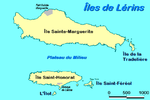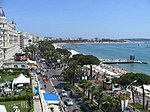Île Saint-Honorat
Islands of Provence-Alpes-Côte d'AzurLandforms of Alpes-MaritimesLérins IslandsTourism in Cannes

The Île Saint-Honorat is the second largest of the Lérins Islands, about 1.6 kilometres (1 mi) off shore from the French Riviera town of Cannes. The island is approximately 1.5 kilometres (0.93 mi) in length (East to West) and 400 metres (1,300 ft) wide. Since the fifth century, the island has been home to a community of monks.
Excerpt from the Wikipedia article Île Saint-Honorat (License: CC BY-SA 3.0, Authors, Images).Île Saint-Honorat
Allée de Ceinture, Grasse
Geographical coordinates (GPS) Address Nearby Places Show on map
Geographical coordinates (GPS)
| Latitude | Longitude |
|---|---|
| N 43.507777777778 ° | E 7.0458333333333 ° |
Address
Chapelle Saint-Michel
Allée de Ceinture
06407 Grasse
Provence-Alpes-Côte d'Azur, France
Open on Google Maps









